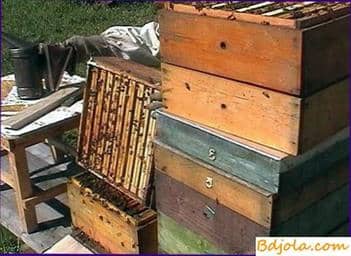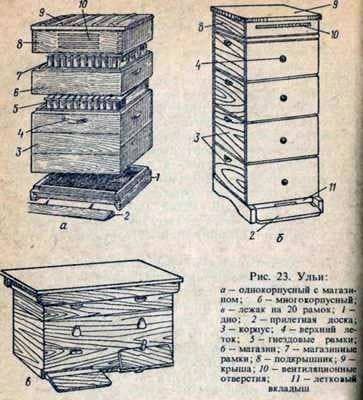
Requirements for the hives. The beehive is the home of bees, an artificially created man, so it must most fully satisfy the biological characteristics of the bee family and at the same time be strong enough, cheap, easy to manufacture and convenient to work with. As a home for bees, the beehive must be sufficiently spacious, warm, dry, and well ventilated. Important in this case is the correct observance of the distances between the individual parts of the hive and the frames. Thus, the distance between the walls of the hives and the side slats of the frames is 7.5 mm, and the superframe space should be 10 mm. In this case, the bees can freely move from the frame to the frame or from the lower case to the upper one.
The sub-frame space (the distance between the bottom of the hive and the lower frames of the frames), on the contrary, is increased to 20 mm for better ventilation of the socket.
Great importance for the normal life of a bee family has a distance between two adjacent cells (the street). Usually the size of the street in the nest is 12.5 mm.
Frame hive device.
The hive consists of the following parts: the bottom with the landing board of the hull, the roof with the overburden, the shop, the frames of the platen boards (diaphragms) and, sometimes, the ceiling boards.

The bottom of the hive is detachable or deaf. The advantage of the detachable bottom is that in the hive you can place a mesh stretcher with a tray to collect varroa mites and periodically remove parasites.
In areas with a cold protracted spring, a dull bottom is usually preferred. In the sun beds also make the bottom deaf. In both cases, the bottom consists of a flap, knocked down from planks and straps from the beams. In the front bar of the bottom a slit is made, forming a lower tray with a height of 12 … 15 mm. The width of the tap on both sides is adjusted with inserts. To the front bar of the bottom is attached a landing board, which, as a rule, is folded. When transporting a boarding board, cover the bottom hive of the hive.
The body consists of four walls. In the upper edge of the front and back walls of the body, a rebate is chosen for hanging the nested frames, resting on it with their shoulders. In the upper part of the front wall of the body there is an upper duct of longitudinal or round shape. Depending on the design of the hive, the walls of the hull are made single or double. In the latter case, warming material is placed between the walls (tow, cotton wool, fire, sphagnum moss). For sunbeds, double often make only the front and rear walls. This facilitates their mass. In such a beehive, the bee family is placed in the center of the hive in autumn and spring, and the nest is bounded from the sides by diaphragms and insulated with pillows.
The roof of the hive is made flat, odnoskatnoy or gable. A flat roof is additionally covered with roofing felt, roofing iron or well-colored cardboard. The roof is almost always removable, only the hive-lounges sometimes recline on hinges. In the anterior, and sometimes in the rear wall of the vertical strapping of the roof make ventilation holes, necessarily barred from the inside by a fine mesh.
Depending on the system of the hive, the pod is made detachable (for example, in double-hulled and multi-hull beehives) or connected to a roof in one unit (hives-hives). Serves to accommodate the pillow, which insulates the nest on top.
The store, or store extension, is placed on the hive body during the period of honey collection, as soon as the nest of the body is filled with bees and brood. It is intended solely for bees folding honey. In height, the store is half the size of the case. The store is usually put less than half-frames compared with the body in such a way that the size of the streets was not 12, but 18 … 19 mm. In this case, the bees will lengthen the cells, make them honey, and the uterus can not lay eggs in them.
The plaque (diaphragm) separates the nest of the bees from the empty space of the beehive. Suspended on the shoulders, like the frame. When assembling the nest in the middle of the hive, the nest is limited by two diaphragms.
The ceiling is the upper shelter of the nest of bees, sometimes used instead of a canvas. It consists of thin plates, closely adjacent to each other. They are placed over the nest parallel to the frames directly on the sides of the walls of the hive or to selected folds.
Typical hives.
Multiple hull. It consists of 4 buildings, each of which accommodates 10 frames in the size of 435 x 230 mm. The case is single-walled, made of boards with a thickness of 35 mm. On the outside of the side walls of the body are selected shells – recesses to capture the body during transport. The bottom is detachable, with protrusions for attaching the landing board, which, when transported, is placed in an upright position to block the tap. The ceiling consists of 5 boards fastened with two strips, and it can be used as a horizontal diaphragm, placed between the bodies. The roof is flat, covered with tin. The frames are made with permanent dividers, so the width of the side strips in the upper third is 37 mm, the bottom is 25 mm.
Two-hull beehive. It consists of two buildings, each of which accommodates 12 nesting frames of 435 x 300 mm, or one enclosure with 12 nesting frames and two magazine extensions, each of which is equipped with 10 … 12 store frames with a size of 435×145 mm. The thickness of the walls of the case, as well as the front and back walls of the shops is 40 mm, the lateral walls of the latter are 30 mm. The bottom is deaf, the lower duct is 15 mm high, the upper one is round, with a diameter of 25 mm. In the side walls of the body are selected recesses for gripping. In one of the magazine extensions, a round chute with a diameter of 25 mm is made. Extensions are interchangeable, and they are used separately as shops or 2 as a second housing to accommodate the nesting frames. The roof is flat, consists of a strap with a height of 105 mm and a shield. In the end walls of the binding around the entire width make ventilation holes,
Beehive lounger. It consists of a body housing from 20 to 36 nesting frames with a size of 435 x 300 mm and a magazine extension for the same number of half-frames 435 x 145 mm in size. The front and back walls of the case are made of boards with a thickness of 40 mm, side panels – 30 mm. The bottom is deaf. The bottom flume of 12 mm height is divided into 2 or 3 parts by fixed bushings, the upper flanges are also 2 or 3 depending on the capacity of the hive, and they can be round, 25 mm in diameter or slit 12×100 mm. The roof is made flat or odnoschatnoy with strapping height of 80 mm. In the piping, cut the ventilation holes, closed with a grid with 3 mm cells.
Медовик на весь противень. Щавельная кислота для обработки пчел.
Hives, inventory